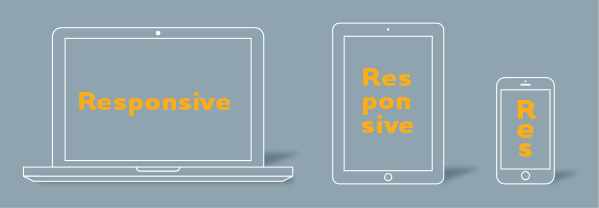
by davidlecours | Jul 3, 2013 | Web & Digital
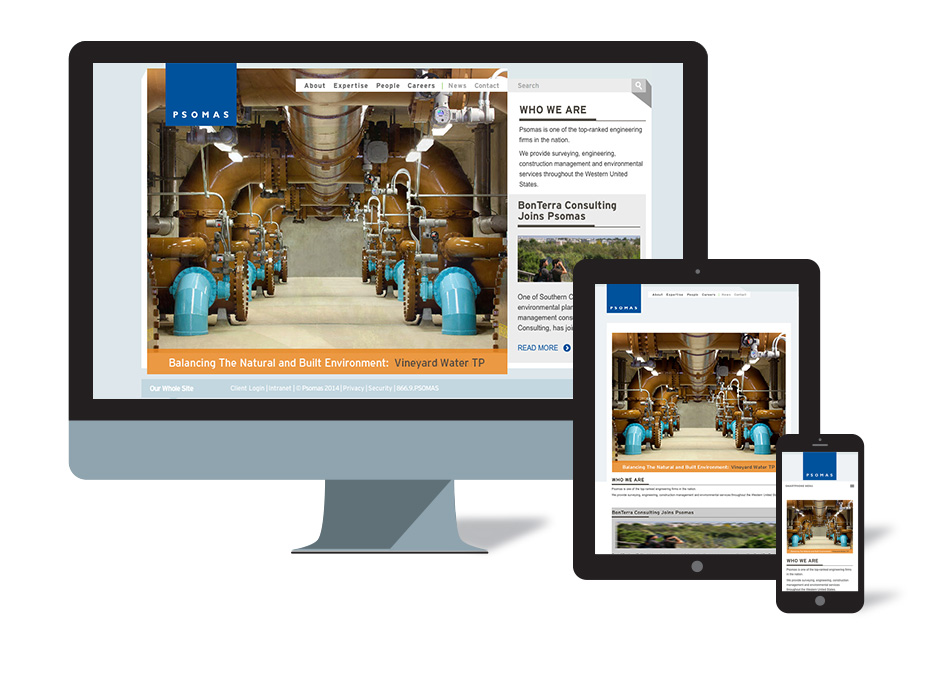
Most A/E/C firms tout proficiency with the latest technology and excellence in user experience (a.k.a. client service) written on their websites. But if those websites are only designed for viewing on a desktop computer, then they are contradicting any claims of technology or user experience prowess. The medium must match the message.
Have you had the painful experience of navigating a website on your smart phone by pinching in and out to touch one button without accidentally hitting the adjacent button? It reminds me of the childhood board game Operation where you test your dexterity by tweezing out body parts without getting zapped. Responsive Design prevents your website users/visitors from getting “zapped.”
Your next A/E/C firm website must incorporate Responsive Design because it provides an optimal user experience on all screen sizes. In this post, I’ll share the following:
- What is Responsive Design?
- How Does Responsive Design Work?
- Why Do You Need a Responsive Design Site?
- Who is Using Responsive Design?
What is Responsive Design?
Responsive Design is a new design and coding approach to provide an optimal user experience based on the user’s screen size and orientation. The content of the site “responds” to fit a smart phone, tablet, laptop or desktop computer.

“Instead of building alternate versions of your website for mobile devices or platforms, responsive design is a method that allows you to build one site that adapts to the context in which it is viewed” explains Chris Butler, author of The Strategic Web Designer.
If you are into etymology, the term “responsive design” originated from a 2010 blog post from Ethan Marcotte.
How Does Responsive Design Work?
You don’t want to hear technical nerdspeak about code, so I’ll focus on what the user experiences when viewing a responsive design site. Responsive design is based on a fluid grid that adjusts the layout of the site based on the size of the visitor’s screen. Here are 3 screen sizes and what happens to the content.

Why Do You Need a Responsive Design Site?
1. Mobile
By summer 2013, there will 7.1 billion mobile subscriptions. This equals the number of humans on the planet. Since we look at our mobile phones, on average, 150x per day, there’s a good chance that your website will be viewed on a mobile phone. Responsive design helps to ensure the user experience on your website is favorable regardless of screen size. At best, the technology is transparent and the user simply finds what she needs. At worst, the user notices the responsive design and makes a mental note of your firm’s technical savvy.
If your website is not optimized for mobile, users may hate your website . A 2012 survey of mobile users by Sterling Research and SmithGeiger show that nearly half of all mobile users say they feel “frustrated and annoyed” when visiting poorly mobile optimized sites. And 36% say they feel like “they’ve wasted their time” when they visit those sites. Responsive design can fix this.
2. Content Marketing
If your firm engages a content marketing strategy, and it should, responsive design supports users engaging with your content regardless of their device. User’s often begin consuming content on one device, only to finish on another. I often browse my twitter stream in Hootsuite on my phone, and send longer blog post links via Evernote to read later on my iPad. I may get an email on my desktop computer about a firm I’d like to research, then send it to Evernote to read later on my iPhone while waiting at the airport. Your website, and it’s content need to live and work like you do (everywhere).
3. Single Site, Single Web Address
The old model was to create a separate website for each device: desktop, tablet and phone. This tripled the amount of design and coding required. It often resulted in dumb-downed versions of your site for phones. It also potentially created 3 different URLs: desktop.you.com, tablet.you.com, and phone.you.com. Which URL do you use, or do others use, when virally sharing your brilliant content? Responsive design let’s you update and share one URL: you.com.
Successful Examples of Responsive Design
Time magazine recently upgraded Time.com to a responsive site. Their pages viewed per visit, mobile, tablet and desktop usage, are all up considerably:
Mobile is up 23%
Home Page uniques are up 15% and time spent is up 7.5%
Mobile bounce rate decreased by 26%
time.com
davidlecours.com
lecoursdesign.com (this site)
psomas.com
moonmayoras.com
Conclusion
Is Responsive Design simply a website trend that will become obsolete 5 years from now? I doubt it. But the web is always evolving. I can guarantee you there will be something new down the road. If you want to back up your project delivery claims of using the latest technology, plan to update your website every 3″“5 years. If you are planning a a new website now, call David Lecours 760-632-7619. We’re very responsive.

by davidlecours | May 3, 2013 | Content Marketing

I recently received a call from a client that we hadn’t worked with in 10 years. The client said, “I received one of your advice emails and it was really good. I get a lot of these from vendors and I rarely read them. But I consistently read yours because they are thoughtful, helpful, and I like your voice. Our firm is going through some strategic changes and I’d like to discuss having you help us communicate our new voice.”
I loved getting this call because:
- It validated that the content I share is useful
- By being myself, my voice connected with a prospect
- By sharing advice on a consistent basis, it arrived when the prospect had a need for our services
The call led to a brand strategy assignment that led to two new brand identity projects, websites, and more. This reinforced my belief that Content Marketing is essential for AEC firms (and consultants like me who serve them).
What is Content Marketing?
The sharing of expertise in exchange for your audience’s attention. Also called Inbound Marketing because it pulls prospects toward you in an inbound direction. As opposed to outbound marketing channels like advertising or direct mail where your message is being pushed out towards prospects.
“Unlike traditional advertising which interrupts customers to get noticed, content marketing provides content that customers want in exchange for permission to market a product or service.” ““Kiss Metrics
Content Marketing Takes Many Forms
Content Marketing isn’t new. People have been speaking at conferences and writing newsletters for the last century. What’s new is the distribution ease via the internet. I’ve listed the major forms of content marketing here (from moderate to very difficult):
- Shared Images (Pinterest, Instagram, Flickr, etc.)
- Social Media Posts
- Case Studies
- Blog Posts – shorter form ~500 words
- Newsletter – long form articles. 1k words +
- White Papers
- Writing For External Publications
- Webinars
- Speaking
- Podcasts
- Videocasts
- Info graphics
Why Content Marketing Works
As you know, AEC firms have the challenge of selling expensive services on the promise of future delivery. This requires trust on the part of the buyer. Traditionally, that trust was only gained after delivering the promise of a project. Content marketing works as a shortcut to gaining a buyers trust before hiring you. The prospect has the opportunity to experience your expertise in a low risk, non-sales environment. Nobody likes to be sold; content marketing gives the buyer the opportunity to learn how you think before taking any risk of hiring you.
Content marketing works on the principle of reciprocity as highlighted in the marketing classic, Influence: The Psychology of Persuasion by Robert Cialdini. Human are driven to resolve the inherent tension of being indebted to another. When we give away something of value (our expertise), prospects feel a psychological urge to “even the score.” Try before you buy lets prospects experience your thinking, but it also puts them slightly in debt to you.
More Benefits of Content Marketing
- Pre-positions your firm – sharing content demonstrates your expertise before the RFP comes out
- Having time to develop content communicates that you have a well run business
- Communicates helpful confidence, not desperation
- You have to do less “selling”
- Boosts SEO – Google likes original content being added to your website
- Educate prospects to the point where they are ready to hire you
- Great content gets shared (residual exposure within your niche)
- Content can, and should, be highly targeted
- It makes you smarter – you gain clarity when you share your expertise with others
“The antidote to fear is knowledge. Knowledge is not complete until it is articulated and publicized.” ““David Baker
Conclusion
In the race towards gaining the trust of a potential client, content marketing can provide a shortcut. It can allow a prospect to get to know you, like you, and eventually trust you enough to hire you.

by davidlecours | Mar 19, 2013 | Web & Digital

If you have this nagging sense that your AEC firm website could be more than an online brochure, you’re right. The modern website doesn’t sit idle waiting for the arrival of a visitor to simply confirm what they’ve already heard about your firm. When combined with narrow positioning and content/inbound marketing, a good website becomes a business development tool.
Here’s an example:
A city planner wants to know best way to gather public input for a new park being considered years from now. She searches for “public input methods for city parks” via Google. A blog post titled What Works: Public Input for Public Parks is one of many search results. Google likes to return local results so this blog post written by a local landscape architecture and planning firm (Firm X) ranks highly. The planner knows that her city will eventually need to hire a firm to design the park, so she’s curious about the perspective of Firm X. The Planner clicks the link and is directed to the blog section within the Firm X’s website. The blog post offers several insightful suggestions that make the planner look good when she recommends these ideas to her Planning Commission. At the end of the post, there are links to similar articles. She is too busy to read them now so she bookmarks the links. Knowing that she will forget about these bookmarks, she subscribes to the firm’s newsletter. Now she won’t have to remember to go back to the firm’s blog because useful articles will show up in her email in-box. Her contact info automatically gets entered into Firm X’s CRM. The park project is put on hold and a year goes by. The city now plans to create a walking trail and puts out an RFP for design. Since she regularly receives free valuable advice from Firm X, the city planner sends them a link to the RFP. Firm X wins the job in the presentation interview because the selection committee felt like they knew and trusted Firm X after hearing a Principal speak on Trends in Trail Design at a recent conference.
The best professional service websites attract the unaware, demonstrate your expertise, connect personally, and convert visitors into prospects.
Attract
If your firm is clearly and narrowly positioned to attract a specific audience, then your website can reach and engage the unaware. These visitors may be potential clients or employees. Both are important to the success of your firm.
A benefit of knowing your target audience is knowing what keeps them up at night. Searchable and optimized content on your website that soothes client pain points will increase your odds that unaware prospects find you. Once they find you, they will devour your content because it seems like it was written just for them.
“A main opportunity is to attract the unaware: those who need your expertise but are unaware you exist or not considering you.” ““Mark O’Brien, Author of A Website That Works.
By regularly adding unique, expertise-based content to your site, you will boost SEO. You begin to convey to Google who you are, which helps Google send the right visitors. The visitors like your content because it feels customized for them. Then visitors start linking to your content. Google notices this and increases your search rankings.
Demonstrate Expertise
A good website can allow someone to get to know (as described above) to like to trust your firm. This happens by demonstrating your expertise in writing. This can be blog posts, white papers or monthly newsletters. Make sure the content is indexable (not a PDF), so Google, and visitors, can find it.
A commitment to regularly adding valuable and searchable content to your website demonstrates your expertise and works to pre-position your firm as a leader before the RFP comes out. Content marketing is so critical for professional services because we are “selling the invisible.” Buyers can’t see, touch, or test our services before they buy. Content marketing is a no pressure, non-sales manner for prospects to understand how you think, what you believe, and how you’ve solved previous problems.
Creating engaging content is hard to do. Most will give up after a few months. This is an opportunity to stand out.
I recommend starting with writing a blog. then graduate to:
• quarterly webinars
• white papers
• speaking where your clients gather
• videos & podcasts
Connect
The mantra I hear repeated is: A/E/C marketing is a relationship business. People do business with people they know. Yet, I’m shocked how many firms are unwilling to highlight firm leaders on their website out of fear that this talent will be poached. Guess what? Your competition already knows who your leaders are. If your leaders’ loyalty is so fragile that an email from a competitor will cause them to jump ship, then you’ve got bigger issues.
While there is no substitute for meeting someone in person, you can begin a relationship by making an emotional connection online. No, not online dating. Do this in the People section of your site by showing some personality. We recently designed a site where we asked magazine style questions to the leaders. You could also use a video of someone telling a client story. Avoid the cold bio with only facts. Avoid the stiff headshot where everyone looks the same. Give website visitors a reason to like the people that they may eventually work with.
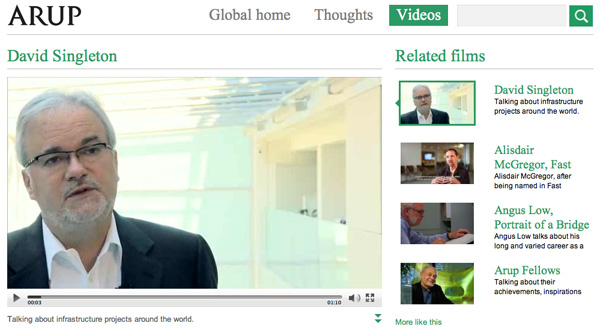
ARUP lets visitors get to know leaders in their own words using video.
Convert
The sales cycle for professional services is long and involves multiple steps. Nobody is going to visit your site and wonder where your shopping cart is so they can purchase your services with PayPal. However, in exchange for your valuable content, visitors are willing to give you their trust and attention in the form of their name and email address.
You may be reluctant to place sign-up forms on most of your pages, because you feel it is too “sales-ey” for a professional service firm. Get over this concern. Visitors won’t go to all the pages on your site so you don’t want to miss a conversion opportunity by only putting a sign-up form on your Contact page. If you are offering valuable content, you are helping visitors by allowing them sign up for your e-newsletter. Then they don’t have to remember to go consistently return to your site.
Conversion should be accomplished through a clear, concise and compelling call-to-action form (see below). The form should include Name and Email (no more) and a link to examples of the type of content they will receive. Keep the form concise to minimize resistance in the sign-up process.

Sign-up form for Randall Lamb
Since the sales cycle is long, it’s critical to get someone into your CRM and put them on a consistent drip of valuable content. When they become ready to buy your services, your firm will remain front of mind.
“No single piece of content, no matter how excellent, will be as successful as a steady, long term flow of quality content.” ““ Chris Butler, Author of The Strategic Web Designer
Conclusion
Websites have evolved from passive brochure-ware to active lead generating tools. Here are some A/E/C industry examples of sites doing this well:
Randall Lamb Engineers
Array Architects
DPR Construction
ARUP

by davidlecours | Feb 14, 2013 | Web & Digital

When we develop websites for AEC firms, the topic of Search Engine Optimization (SEO) usually comes up in the project kickoff meeting. Our client, the Director of Marketing or CMO, needs to respond to the CEO, who has asked, “Can we get to the top of page one of Google search results with this new website?” Probably Not. For most generalist AEC firms, spending a lot of time and dollars on SEO doesn’t make sense.
Your clients don’t search for: “architecture firm,” view the search results, go to a website, select your services in a shopping cart, and then click “buy” at check out. But if your firm has specialized expertise and a content marketing program (it should), then SEO makes sense. This post shares how adding valuable, unique content, and then optimizing your pages, can help you attract searchers that arrive at your site already hungry your firm’s expertise.
“SEO only works for Professional Service firms when combined with a narrow focus and regularly adding expert content that is helpful to your target audience. A modern website requires a commitment to specialization and a commitment to writing.” ““ Mark O’Brien, CEO of Newfangled and author of A Website That Works.
Note: I use Google in this post as the defacto search engine because they currently have an 84% market share. While Bing is gaining momentum, if you adhere with Google SEO practices, you will be well positioned with Bing and others.
What To Do
- Add unique, valuable content informed by your expertise to your website blog
- Optimize each page of your website
- Google indexes this content, and brings interested searchers to your site
- Searchers arrive impressed with your helpful expertise
- They sign-up for your newsletter or RSS feed, and tell their colleagues about your site
- Colleagues start linking to specific pages in your site
- Google indexes more frequently, and increases your rankings
What to Avoid
- Hiring an expensive “SEO Expert” promising to put your firm at the top of page 1.
- Trying to outsmart Google. You will not.
- Trying short term tricks that could get you “blacklisted” from Google.
- Developing a “magic keyword list” assuming it will automatically drive your listing to page 1.
How To Optimize Your Pages
Here are the six items you should pay attention to when optimizing your web pages.
1. URL – Uniform Resource Locoator or Page Link

Appears: Title Bar (see red arrow above)
Length & Format: As short as possible to describe page
Concept: friendly, english (not code), concise, keyword-rich
Example: https://lecoursdesign.com/about/clients/
Best Practices: Have developer give you ability to customize URLs through your CMS
Avoid: Code URLs like this: http://yourname.com/main.cfm?&projDetail=1&thesection=projects&projView=
service&thesubsection=Federal&thepage=02Fort%20Huachuca%20Military%20.html
2. Page Title

Appears: Browser Bar & link text in Google results (see red arrow above)
Length & Format: Up to 70 characters
Concept: Keyword or Phrase, Keyword or Phrase, Keyword or Phrase
Example: Grateful for Great Clients
Best Practices: Accurately describe page content, unique for each page, More important keywords towards front, think like a searcher
Avoid: A single tag across all your pages, long confusing titles
3. Meta Description
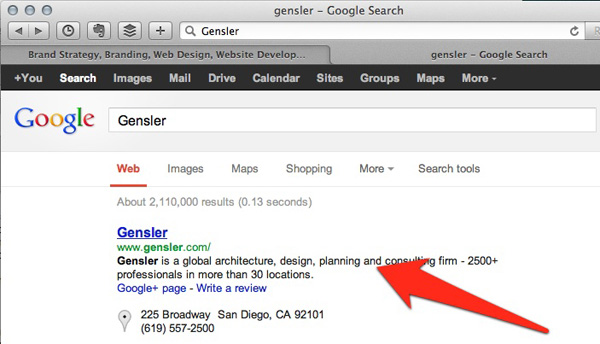
Appears: black text in Google results (see red arrow above)
Length & Format: Up to 155 characters
Concept: Compelling ad copy that inspires user to click
Example: Home: LecoursDesign is a brand strategy firm serving the AEC Industry. We help clients tell their story to win new business.
Best Practices: Accurately summarize page content
Avoid: only keywords, generic descriptions, quotes
4. H1 Tags
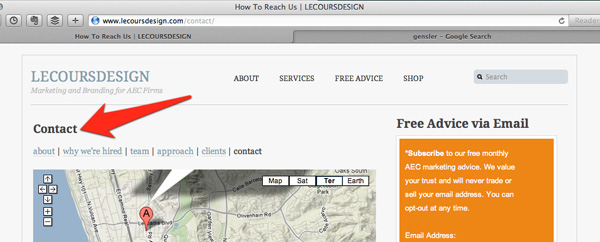
Appears: Headline title on each page (see red arrow above)
Length & Format: No more than 1 line, could be 1 word
Concept: Compelling headline that ideally contains primary keyword for that page
Example: Contact
Best Practices: Every page needs a unique H1 tag
Avoid: making H1 tags exact copies of page titles
5. Keywords
Appears: n/a
Length & Format: 5-6 words or phrases comma separated -or- 1 primary keyword (there are differing beliefs on this)
Concept: primary keyword, secondary keyword, etc. if using multiple keywords
LecoursDesign Example: Brand Strategy, Branding, Logo, Web Design, AEC Marketing
Best Practices: Think like a searcher. What words would they use to find you. Unsure about which words to use? Use http://www.google.com/trends/. For example, I was unsure about which keyword is searched for more frequently: brand or branding. Below are the results:
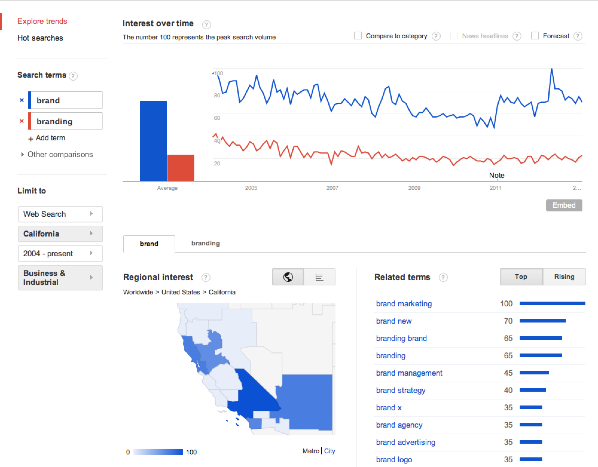
6. Body Copy
Write compelling content that is helpful to your audience. Speak directly to your reader by identifying their pain points and offering solutions. This post is an example. I heard from several clients that they were confused about SEO so I wrote this post to help them. Use keywords in your body copy but only when they make sense. In other words, don’t keyword stuff at the expense of good writing. You want incoming links and nobody will link to your copy if it isn’t readable. In short, if your content isn’t good enough to attract natural links, it doesn’t matter how “optimized” that content is. Finally, make sure content is indexable, not PDFs, movies, image files, etc. A quick way to test is to place your cursor over the text and try to select it. If successful, then it’s indexable.
The Opportunity
The main opportunity with search is attracting potential clients that value your expertise, are unaware of you or your current services, or are considering hiring someone else. It’s unlikely that you’ll convert them on the spot to become a client. But, a relationship with this potential client must start somewhere. Content Marketing + SEO can be the first step in moving this searcher from prospect to client by getting to know you, to like you, to trust you, and eventually hire you.
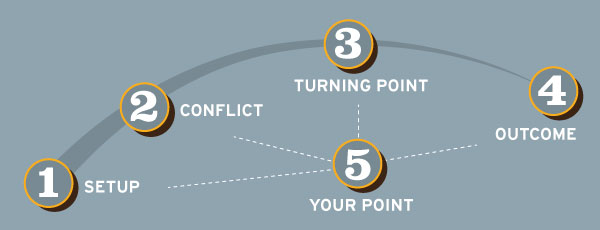
by davidlecours | Nov 13, 2012 | Story

Marketers are buzzing about “story.” Ten years ago, we were frothing about “branding.” Like “branding,” I’m concerned that the term “story” is being applied too liberally, and will lose its credibility. To avoid this, we need to be precise when referring to “story.” Story has a definite structure. By learning this timeless structure, all AEC marketers can better tell stories to win new business.
Robert McKee, a Fulbright Scholar praised in Hollywood for his consulting on narrative structure defines story as “the expression of how and why life changes. A story begins with balance, then something throws life out of balance, then a story goes in to describe how balance is restored.”
In previous posts, I shared why AEC Marketers should use story (the why), and the three stories we must master (the what). Now, I’ll recommend how to craft your stories (the how). Story structure will make your stories, and firm, more memorable. Stories move a prospect along the continuum of getting to know, like, and trust you, and your firm. Well constructed stories filled with emotion and vulnerability build relationships. As you know well, relationships win new business.
Story Structure 101
After reading a gripping novel or seeing a moving film, have you ever wondered if there is a secret formula for story success? There is, and it’s no secret. You may have heard of the famous 3 act play: Introduction, Rising Action, Resolution. I prefer the structure below from What Great Salespeople Do: The Science of Selling Through Emotional Connection and the Power of Story by Mike Bosworth and Ben Zoldan. These 5 stages are the “secret sauce” for all great stories. I’ll use an example of an AEC “Who We’ve Helped Story” to illustrate these 5 stages.
- Setup – This is where you drop your listener into your story. Quickly ntroduce your characters, location, and any relevant background information. To make your protagonists likable, share what makes them human (dreams, fears, desires, etc.). The audience needs to connect with your project team and want them to succeed.
- Conflict – If there is no struggle, there is no plot. It just isn’t interesting. There needs to be something formidable that stands in the way of your project team’s success. In the AEC world, this could be timing, personalities, budget, politics, or physical constraints.
- Turning Point – Stories are explanations of how and why life changes. This is the aha moment that changes your team. This could be some new insight that alters how your team solves problems on the job site, or the reason why you entered a new market. The turning point could even be an epiphany that changed the strategic direction of your firm.
- Outcome – This is an untangling of events in your story. Think of movie credits rolling where we learn what your favorite characters are doing with their lives today. The resolution explains how your story ends and what effect the experience has had on your team.
- Your Point – In this stage, you reinforce your theme or point of your story. This is often a core belief or value that your firm holds. If your firm has a new way of delivering projects, this is where you would share that process. It might sound something like this, “as a result of what we learned by continuously overcoming X, our firm believes that Y not only is the best way to deliver projects, but it also separates us from our competition.
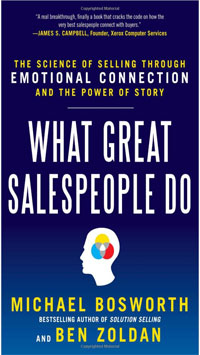
Recommended Story Development Process
The way in which you develop a good marketing story is not the order in which you ultimately write or tell that story. Because clarity and brevity are so important in marketing stories, write or tell the story in chronological order (stages 1 thru 5 above). Develop the story in this order:
- Your Point – Ask yourself, “why am I/we telling this story?” Possible answers may be to share your impressive safety record, demonstrate your creativity, or persuade that your project delivery method saves money. Always start with why.
- Outcome – To make sure your story ends in a way that supports your point.
- Setup
- Conflict
- Turning Point
Now you have the key elements, practice writing or telling the story in chronological order.
Share Emotion
Great story structure without emotion is like a jumpy house before it’s been inflated. Emotion gives it life, makes it interesting, and ultimately memorable. There are 6000 words in English to communicate emotion. Use them to describe how your main characters feel, not just what happened. If you just recount the facts, expect to put your audience to sleep. Consistently ask yourself, how did your protagonist feel at each stage of the story. Feelings are the glue that constructs real and likable characters. Emotional connection is also what makes your story, and your firm memorable.
Reveal Vulnerability
This is the hardest thing to do for AEC firms. Our work is so highly technical, and we are consistently asserting our expertise, that to reveal vulnerability seems weak. But we actually gain power when revealing vulnerability. Try this with a friend. Reveal something you may be struggling with, or a mistake you’ve made and watch what happens. Because of what neuroscientists call mirror neurons, your friend will most likely share something vulnerable in return. In simple terms, this “monkey see, monkey do” behavior is a mutual exchange of emotion. This is the definition of a relationship. By telling your story, your prospect may tell you their story. This is where you learn what your prospect’s pain points are, and what you can do to solve them. It takes courage, but going first in revealing vulnerability, is critical. You establish that it’s safe to be real, that your prospect can trust you with their authentic story. It’s counterintuitive, but vulnerability makes you more likable, not less. Perfection is boring, stiff, and lifeless. It’s our imperfections, that make us likable. Stories about when your firm made a mistake, what you did to correct that error, and what you learned, are incredibly powerful relationship builders.
Nothing is more intimidating to a writer than a blank sheet of paper. My intention is that this post serves as a template for you to jump-start your stories. By utilizing a proven story structure, and integrating emotion and vulnerability, you will create stories that elevate your firm’s proposals, presentation interviews, and websites to win new business.
What Do You Think?
Does having a structure constrain or enhance your creative storytelling?
Any examples of where you’ve revealed vulnerability, and it’s helped or hurt you?
Related Posts
Why AEC Marketers Must Master The Power of Story (The Why)
3 Stories AEC Marketers Must Master (The What)
Recommended Books on The Power of Story To Win New Business
What Great Salespeople Do: The Science of Selling Through Emotional Connection and the Power of Story by Mike Bosworth, Ben Zoldan
The Story Factor by Annette Simmons
Tell to Win: Connect, Persuade, and Triumph w/ Hidden Power of Story by Peter Guber
resonate: Present Visual Stories that Transform Audiences by Nancy Duarte
Made to Stick: Why Some Ideas Survive and Others Die by Dan and Chip Heath
by Dan and Chip Heath
A Whole New Mind: Why Right-Brainers Will Rule the Future by Dan Pink
by Dan Pink
















